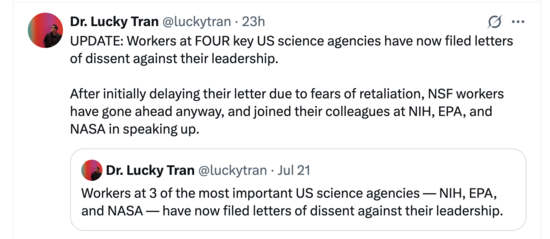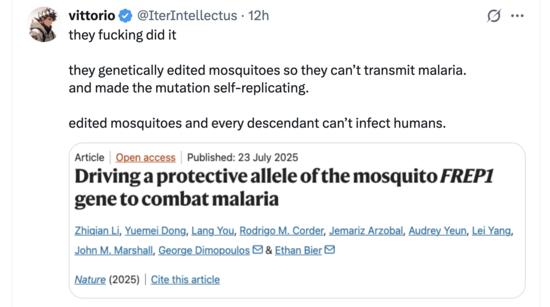Earth’s underground networks of fungi need urgent protection, say researchers — the guardian
Scientists from the Society for the Protection of Underground Networks (Spun) have created the first high-resolution biodiversity maps of Earth’s underground mycorrhizal fungal ecosystems.
The research, published in the journal Nature on Wednesday, found that 90% of the biodiverse hotspots of mycorrhizal fungi were in unprotected ecosystems. Loss of the ecosystems could lead to reductions in carbon drawdown, crop productivity and ecosystem resilience to climate extremes.
Mycorrhizal fungi have “remained in the dark, despite the extraordinary ways they sustain life on land”, said Dr Toby Kiers, the executive director of Spun.
“They cycle nutrients, store carbon, support plant health, and make soil. When we disrupt these critical ecosystem engineers, forest regeneration slows, crops fail and biodiversity above ground begins to unravel … 450m years ago, there were no plants on Earth and it was because of these mycorrhizal fungal networks that plants colonised the planet and began supporting human life.
“If we have healthy fungal networks, then we will have greater agricultural productivity, bigger and beautiful flowers, and can protect plants against pathogens.”
Sex at birth is not always random — mum’s age and genetics can play a part — nature
In families with several children of the same sex, the odds of having another baby of that sex are higher than of having one of the opposite sex, according to a large study1 that investigated the maternal and genetic factors that influence the sex of offspring.
The results, published in Science Advances today, find that in families with three boys, there is a 61% chance that the next sibling is male. For families with three girls, there was a 58% chance that the next child would be female. […]
The authors note that changes in vaginal pH as women age could explain this phenomenon. For instance, the changes could influence the sex of the child by affecting whether sperm carrying the X chromosome or the Y chromosome are more successful at fertilizing the egg, says Polyakov.
From Cochise to Congress: How Local Extremism Threatens Wolves—and the Endangered Species Act — counterpunch
This spring, after a few confirmed wolf-related livestock kills in Cochise County, Arizona, some ranchers claimed unverified additional losses and pushed county officials to take drastic action. Backed by industry groups and emboldened by national political shifts, they called for the Mexican gray wolf to be stripped of its endangered status and for the recovery program to be defunded—part of a broader nationwide campaign to weaken the Endangered Species Act (ESA). […]
There are now no wolves in Cochise County. And this fact is being celebrated by those pushing the false narrative that we cannot coexist with wolves.
Such power plays distort policy, intimidate decision-makers, and create a chilling effect on any meaningful enforcement of the ESA. These wolves were part of the most genetically valuable population in the recovery program. The removals were clearly aimed at appeasing livestock interests, even though the recovery of wolves is a broadly-valued federal mandate under the ESA. Why do the loudest and most extreme voices—those pushing misinformation and hostility—get outsized consideration over wildlife watchers, Indigenous leaders, scientists, and the majority of the public who support wolf recovery?
New global study shows freshwater is disappearing at alarming rates — phys.org
New findings from studying over two decades of satellite observations reveal that Earth’s continents have experienced unprecedented freshwater loss since 2002, driven by climate change, unsustainable groundwater use and extreme droughts. The study, led by Arizona State University and published today in Science Advances, highlights the emergence of four continental-scale “mega-drying” regions, all located in the northern hemisphere, and warns of severe consequences for water security, agriculture, sea level rise and global stability.
The research team reports that drying areas on land are expanding at a rate roughly twice the size of California every year. And, the rate at which dry areas are getting drier now outpaces the rate at which wet areas are getting wetter, reversing long-standing hydrological patterns.
Record marine heat waves in 2023 covered 96% of oceans, lasted four times longer than average — phys.org
Heat waves aren’t just getting worse on land, the majority of the world’s oceans are experiencing record-breaking temperatures too. These marine heat waves are getting longer, more intense and reaching farther than ever before. In particular, 2023’s marine heat waves (MHWs) exhibited the longest duration, widest extents, and highest intensities on record—and 2024 wasn’t any better.
While humans might feel the impact of land-based heat waves more directly, these MHWs are affecting human activities in alarming ways too. MHWs disrupt marine ecosystems, causing coral bleaching, mass migration and the die-off of various types of sea life. This leads to the reduced availability of seafood resources and, ultimately, job and economic losses in many marine-dependent industries.

Watch the Earth split in real time: Stunning footage reveals a 2.5-meter fault slip in seconds — SCIENCE DAILY PLUS YOUTUBE VIDEO
A colossal 7.7 magnitude earthquake rocked central Myanmar in March 2025, marking the strongest quake in over a century. What makes this event groundbreaking isn’t just the seismic power, it’s the unprecedented footage captured by a CCTV camera near the fault line.
Researchers at Kyoto University used this rare video to measure the fault’s movement in stunning detail, confirming a rapid, pulse-like rupture and a subtle curve in the slip path. This real-time visual data opens a new frontier in earthquake science, potentially transforming how we understand and predict seismic behavior.
Physicists discover new state of quantum matter — phys.org
Researchers at the University of California, Irvine have discovered a new state of quantum matter. The state exists within a material that the team reports could lead to a new era of self-charging computers and ones capable of withstanding the challenges of deep space travel.
“It’s a new phase of matter, similar to how water can exist as liquid, ice or vapor,” said Luis A. Jauregui, professor of physics & astronomy at UC Irvine and corresponding author of the new paper in Physical Review Letters.
“It’s only been theoretically predicted—no one has ever measured it until now.”
Ancient Voice Box Finally Reveals How Dinosaurs May Have Sounded — science alert
Despite what the movies tell us, dinosaurs probably didn’t roar at their prey. It’s more likely that they chirped like birds, based on a well-preserved new fossil with an intact voice box.
A team of researchers from the Chinese Academy of Sciences discovered an almost-complete skeleton of a new dinosaur species in northeastern China.
This two-legged, 72 centimeter (2.4 foot) long herbivore was named Pulaosaurus qinglong after Pulao, a tiny dragon from Chinese mythology that, the story goes, cries out loudly.

Why penguins ride the currents instead of swimming straight home — earth.com
The findings suggest that the birds keep track of the changing tidal cycle and use it to their advantage.
Magellanic penguins are expert navigators. A new study shows they don’t just head straight home from foraging trips. They ride ocean currents and tides, save energy, and grab snacks along the way. […]
The results showed that penguins don’t follow the shortest path. Instead, they adopt curved, S-shaped routes shaped by tidal flows. These winding paths help them conserve energy and find more food.
Record-breaking divers are pushing human limits and reshaping scientists’ view of our species — bbc
Fascinating article not easily summarized- it includes detailed stories about divers who go to great depths, the consequences, and what scientists have learned from studying them.
Humans have a long history of diving to forage from the seabed and today elite freedivers are reaching greater depths than ever. Some researchers argue humans belong in the sea.

NASA unveils incredibly precise new satellite tool that anyone can use: ‘You can zoom in to your country, your state, your city block’ — yahoo news
NASA’s new web portal reveals ground movements across North America with precision that captures tiny shifts smaller than an inch, reported NASA’s Jet Propulsion Laboratory.
This tool helps people monitor the Earth’s movements, whether caused by natural phenomena such as earthquakes and volcanic activity or human activities such as the extraction of underground resources.
By converting complex satellite radar signals into user-friendly visual maps, NASA has made what was once specialist knowledge available to everyday users.
“You can zoom in to your country, your state, your city block, and look at how the land there is moving over time,” said David Bekaert, OPERA project manager and radar scientist. “You can see that by a simple mouse click.”
Right now, you can explore data for areas such as the American Southwest, parts of Mexico’s northern region, and greater New York. The portal displays information for millions of spots on the map. When you click anywhere, you’ll see a chart showing that location’s movement history back to 2016.
